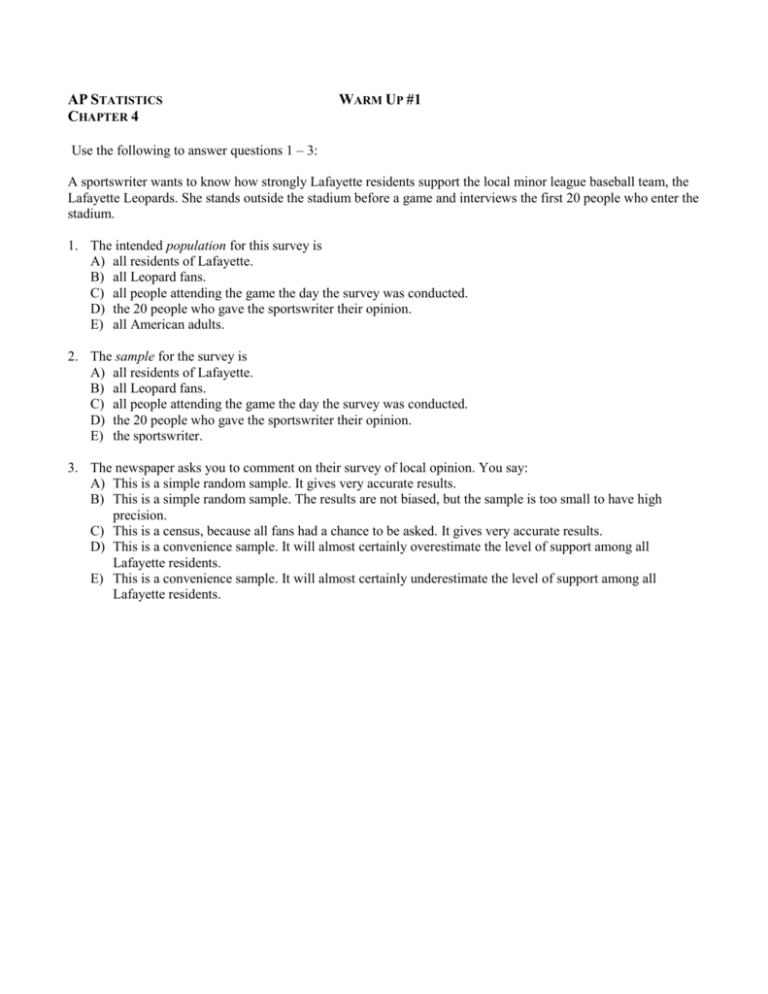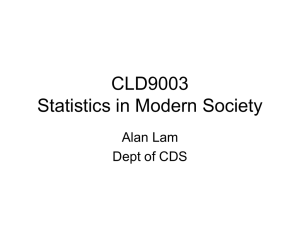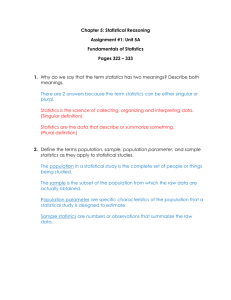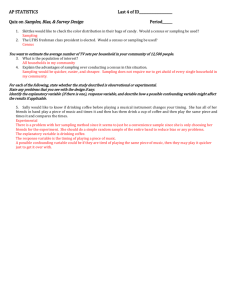CHAPTER 4 - rhsjetmoremath
advertisement

AP STATISTICS CHAPTER 4 WARM UP #1 Use the following to answer questions 1 – 3: A sportswriter wants to know how strongly Lafayette residents support the local minor league baseball team, the Lafayette Leopards. She stands outside the stadium before a game and interviews the first 20 people who enter the stadium. 1. The intended population for this survey is A) all residents of Lafayette. B) all Leopard fans. C) all people attending the game the day the survey was conducted. D) the 20 people who gave the sportswriter their opinion. E) all American adults. 2. The sample for the survey is A) all residents of Lafayette. B) all Leopard fans. C) all people attending the game the day the survey was conducted. D) the 20 people who gave the sportswriter their opinion. E) the sportswriter. 3. The newspaper asks you to comment on their survey of local opinion. You say: A) This is a simple random sample. It gives very accurate results. B) This is a simple random sample. The results are not biased, but the sample is too small to have high precision. C) This is a census, because all fans had a chance to be asked. It gives very accurate results. D) This is a convenience sample. It will almost certainly overestimate the level of support among all Lafayette residents. E) This is a convenience sample. It will almost certainly underestimate the level of support among all Lafayette residents. Use the following to answer questions 4-6: You want to know the opinions of American school teachers about establishing a national test for high school graduation. You obtain a list of the members of the National Education Association (the largest teachers' union) and mail a questionnaire to 2500 teachers chosen at random from this list. In all 1347 teachers return the questionnaire. 4. In this situation, the intended population is A) the 1347 teachers who mail back the questionnaire. B) the 2500 teachers to whom you mailed the questionnaire. C) all members of the National Education Association. D) all American school teachers. E) all American school students. 5. The sampling frame is A) the 1347 teachers who mail back the questionnaire. B) the 2500 teachers to whom you mailed the questionnaire. C) all members of the National Education Association. D) all American school teachers. E) all American school students. 6. The sample is A) the 1347 teachers who mail back the questionnaire. B) the 2500 teachers to whom you mailed the questionnaire. C) all members of the National Education Association. D) all American school teachers. E) all American school students. AP STATISTICS CHAPTER 4 WARM UP #3 1. A study sponsored by American Express Co. and the French government tourist office found that old stereotypes about French unfriendliness were not true. The respondents were more than 1000 Americans who have visited France more than once for pleasure over the past two years. The results of this study are probably A) very accurate, given the large sample size. B) very inaccurate because the sample is only a small fraction of all Americans who have visited France. C) extremely variable, because people's opinions differ so greatly. D) biased, overstating the extent to which the old stereotypes were not true. E) biased, understating the extent to which the old stereotypes were not true. 2. A candidate for mayor of Dallas calls 1,000 people chosen at random from the city telephone directory; 850 of them respond. What are the sampling frame and the sample in this example? A) Sampling frame: the telephone directory. Sample: the 850 people who respond. B) Sampling frame: the telephone directory. Sample: the 1,000 people who are called. C) Sampling frame: the 1,000 people who are called. Sample: the 850 people who respond. D) Sampling frame: all Dallas residents. Sample: the 1,000 people who are called. E) Sampling frame: all Dallas residents. Sample: the 850 people who respond. 3. In order to assess the opinion of students at the University of Minnesota on campus snow removal, a reporter for the student newspaper interviews the first 12 students he meets who are willing to express their opinion. The method of sampling used is A) a census B) a systematic sample C) a voluntary sample D) a convenience sample E) a simple random sample 4. A television station is interested in predicting whether voters in its viewing area are in favor of offshore drilling. It asks its viewers to phone in and indicate whether they support/are in favor of or are opposed to this practice. Of the 2241 viewers who phoned in, 1574 (70%) were opposed to offshore drilling. The viewers who phoned in are A) a voluntary response sample. B) a convenience sample. C) a probability sample. D) a population. E) a simple random sample. 5. A simple random sample is A) any sample selected by using chance. B) any sample that gives every individual the same chance to be selected. C) a sample that gives every possible sample of the same size the same chance to be selected. D) a sample that selects equal numbers of individuals from each stratum. E) a sample that contains the same percent of each subgroup in the population. 6. Simple random sampling A) reduces bias resulting from poorly worded questions. B) offsets bias resulting from undercoverage and nonresponse. C) reduces bias resulting from the behavior of the interviewer. D) reduces variability. E) None of the above. 7. An example of a nonsampling error that can reduce the accuracy of a sample survey is A) using voluntary response to choose the sample. B) using the telephone directory as the sampling frame. C) interviewing people at shopping malls to obtain a sample. D) variation due to chance in choosing a sample at random. E) many members of the sample cannot be contacted. AP STATISTICS CHAPTER 4 WARM UP #2 Use the following to answer questions 1-2: We wish to choose a simple random sample of size three from the following employees of a small company. To do this, we will use the numerical labels attached to the names below. 1. Bechhofer 2. Brown 3. Ito 4. Kesten 5. Kiefer 6. Spitzer 7. Taylor 8. Wald 9. Weiss We will also use the following list of random digits, reading the list from left to right, starting at the beginning of the list. 11793 20495 05907 11384 44982 20751 27498 12009 45287 71753 98236 66419 84533 1. The simple random sample is A) 117. B) Bechhofer, Bechhofer again, and Taylor. C) Bechhofer, Taylor, Weiss. D) Kesten, Kiefer, Taylor. E) Taylor, Weiss, Ito. 2. Which of the following statements is true? A) If we use another list of random digits to select the sample, we would get the same result as that obtained with the list actually used. B) If we use another list of random digits to select the sample, we would get a completely different sample than that obtained with the list actually used. C) If we use another list of random digits to select the sample, we would get, at most, one name in common with that obtained with the list actually used. D) If we use another list of random digits to select the sample, the result obtained with the list actually used would be just as likely to be selected as any other set of three names. E) If we use another list of random digits to select the sample, the result obtained with the list actually used would be far less likely to be selected than any other set of three names. 3. Which of these statements about the table of random digits is true? A) Every row must have exactly the same number of 0's and 1's. B) In the entire table, there are exactly the same number of 0's and 1's. C) If you look at 100 consecutive pairs of digits anywhere in the table, exactly 1 pair is 00. D) All of these are true. E) None of these is true. 4. A public opinion poll in Ohio wants to determine whether or not registered voters in the state approve of a measure to ban smoking in all public areas. They select a simple random sample of fifty registered voters from each county in the state and ask whether they approve or disapprove of the measure. This is an example of a A) systematic random sample. B) stratified random sample. C) multistage sample. D) simple random sample. E) cluster sample. 5. An opinion research firm wants to find the country’s reaction to a speech by a famous politician. They randomly select six states, then randomly select ten Zip Codes from each state. Fifty people from each Zip Code are randomly selected for the survey. This is an example of A) B) C) D) E) convenience sampling. cluster sampling. stratified random sampling. simple random sampling. multistage sampling. 6. A marine biologist wants to estimate the mean size of the barnacle Semibalanus balnoides on a stretch of rocky shoreline. To do so, he randomly selected twenty 10-cm. square plots and measure the size of every barnacle in each plot. This is an example of A) B) C) D) E) convenience sampling. cluster sampling. stratified random sampling. simple random sampling. multistage sampling. 7. A local tax reform group polls the residents of the school district and asks the question, “Do you think the school board should stop spending taxpayers’ money on non-essential arts programs in elementary schools?” The results of this poll are likely to A) B) C) D) E) Underestimate support for arts programs because of undercoverage. Underestimate support for arts programs because of non-sampling error. Overestimate support for arts programs because of undercoverage. Overestimate support for arts programs because of non-sampling error. Accurately estimate support for arts programs. AP STATISTICS CHAPTER 4 WARM UP #4 1. The Bradley effect is a theory proposed to explain observed discrepancies between voter opinion polls and election outcomes in some elections where a white candidate and a non-white candidate run against each other. The theory proposes that some voters tend to tell pollsters that they are undecided or likely to vote for a non-white candidate, and yet, on election day, vote for the white opponent. This is an example of A) voluntary response bias. B) bias resulting from question wording. C) undercoverage. D) nonresponse. E) response bias. 2. Which of the following is not a major principle of good design for all experiments? A) Comparison to a control. B) Replication C) Blocking D) Randomization E) All of these are important principles for every experiment. 3. The essential difference between an experiment and an observational study is that A) observational studies may have confounded variables, but experiments never do. B) in an experiment, people must give their informed consent before being allowed to participate. C) observational studies are always biased. D) observational studies cannot have response variables. E) an experiment imposes treatments on the subjects, but an observational study does not. 4. The most important advantage of experiments over observational studies is that A) experiments are usually easier to carry out. B) experiments can give better evidence of causation. C) confounding cannot happen in experiments. D) an observational study cannot have a response variable. E) observational studies cannot use random samples. Use the following to answer questions 5-8: Does caffeine improve exam performance? Suppose all students in the 8:30 section of a course are given a "treatment" (two cups of coffee) and all students in the 9:30 section are not permitted to have any caffeine before a mid-term exam. 5. Unfortunately, any systematic difference between the two sections on the exam might be due to the fact that the 8:30 and 9:30 classes have different instructors. This is an example of A) placebo effect. B) bias. C) confounding. D) observational study. E) stratification. 6. The response variable in this study is A) two cups of coffee. B) the time the class is held. C) class attendance. D) teacher's performance. E) exam performance. 7. Instead of giving all students in the 8:30 section two cups of coffee, students in the 8:30 section are randomly assigned to a treatment group (two cups of coffee) or a control group (two cups of decaffeinated coffee). The coffee is so bad that students cannot tell whether they are in the treatment or the control group. As it turns out, students in both groups do better on the exam than students in the 9:30 section, who weren't given anything. This could be the result of A) the placebo effect. B) an observational study. C) voluntary response. D) sampling variability E) all of the above 8. Suppose half of the 8:30 students are randomly allocated to the treatment group (two cups of coffee), the other half to the control group (two cups of decaf). In addition, half of the 9:30 students are randomly allocated to the treatment group, the other half to the control group. This is an example of a A) voluntary response study. B) stratified sampling procedure. C) matched pairs design. D) completely randomized design. E) block design. AP STATISTICS CHAPTER 4 WARM UP #5 Use the following to answer 1-2: In order to assess the effects of exercise on reducing cholesterol, a researcher took a random sample of fifty people from a local gym who exercised regularly and another random sample of fifty people from the surrounding community who did not exercise regularly. They all reported to a clinic to have their cholesterol measured. The subjects were unaware of the purpose of the study, and the technician measuring the cholesterol was not aware of whether or not subjects exercised regularly. 1. This is a(n) A) observational study. B) experiment, but not a double blind experiment. C) double blind experiment. D) matched pairs experiment. E) block design. 2. Which of the following best describes the inferences the researcher can make based in his results? A) He can make inferences about cause and effect, but not about the populations from which the samples were taken. B) He can make inferences about the populations from which the samples were taken, but not about cause and effect. C) He can make inferences about both cause and effect and the populations from which the samples were taken. D) He cannot make inferences about either cause and effect or the populations from which the samples were taken. E) There is not enough information to make judgments about the scope of inference. 3. A stratified random sample addresses the same issues as which of the following experimental designs? A) A block design. B) A double-blind experiment. C) An experiment with a placebo. D) A matched pairs design. E) A confounded, nonrandomized study 4. The owner of a chain of supermarkets notices that there is a positive correlation between the sales of beer and the sales of ice cream over the course of the previous year. Seasons when sales of beer were above average, sales of ice cream also tended to be above average. Likewise, during seasons when sales of beer were below average, sales of ice cream also tended to be below average. Which of the following would be a valid conclusion from these facts? A) Sales records must be in error. There should be no association between beer and ice cream sales. B) Evidently, for a significant proportion of customers of these supermarkets, drinking beer causes a desire for ice cream or eating ice cream causes a thirst for beer. C) A scatterplot of monthly ice cream sales versus monthly beer sales would show that a straight line describes the pattern in the plot, but it would have to be a horizontal line. D) It is likely that sales of both beer and ice cream are confounded with a lurking variable, such as seasonal variation in temperature. E) There is a clear, negative association between beer sales and ice cream sales. 5. If changes in a response variable are due to the effects of the explanatory variable as well as the effects of lurking variables, and we cannot distinguish between these effects, we are said to have A) a cause-and-effect relation between the explanatory and response variable. B) a placebo effect. C) confounding. D) correlation. E) extrapolated. 6. In an experiment, an observed effect so large that it would rarely occur by chance is called A) an outlier. B) influential. C) statistically significant. D) bias. E) replication. AP STATISTICS CHAPTER 4 WARM UP #6 1. The principle reason for the use of random assignment in designing experiments is that it A) distinguishes a treatment effect from the effects of confounding variables. B) allows double-blinding. C) reduces sampling variability. D) creates approximately equal groups for comparison. E) eliminates the placebo effect. 2. The principle reason for the use of controls in designing experiments is that it A) distinguishes a treatment effect from the effects of confounding variables. B) allows double-blinding. C) reduces sampling variability. D) creates approximately equal groups for comparison. E) eliminates the placebo effect. 3. The principle reason for replication in designing experiments is that it A) distinguishes a treatment effect from the effects of confounding variables. B) allows double-blinding. C) reduces sampling variability. D) creates approximately equal groups for comparison. E) eliminates the placebo effect. 4. One hundred volunteers who suffer from severe depression are available for a study. Fifty are selected at random and are given a new drug that is thought to be particularly effective in treating severe depression. The other fifty are given an existing drug for treating severe depression. A psychiatrist evaluates the symptoms of all volunteers after four weeks in order to determine if there has been substantial improvement in the severity of the depression. The study would be double blind if A) neither drug had any identifying marks on it. B) all volunteers were not allowed to see the psychiatrist nor the psychiatrist allowed to see the volunteers during the session in which the psychiatrist evaluated the severity of the depression. C) neither the volunteers nor the psychiatrist knew which treatment any person had received. D) the patients were given a placebo. E) all of the above. 5. In comparative trials in medicine, the placebo effect and subconscious bias on the part of the physicians evaluating treatment outcomes can be avoided by using A) the double-blind technique. B) randomized complete block designs. C) response variables. D) stratified random samples. E) all of the above. 6. Twelve people who suffer from chronic fatigue syndrome volunteer to take part in an experiment to see if shark fin extract will increase one's energy level. Eight of the volunteers are men, and four are women. Half of the volunteers are to be given shark fin extract twice a day, and the other half are to be given a placebo twice a day. We wish to make sure that four men and two women are assigned to each of the treatments, so we decide to use a block design with the men forming one block and the women the other. A block design is appropriate in this experiment if A) we want to be able to compare effects on energy level in men and women. B) we believe men and women will respond differently to treatments. C) gender equity is an important legal consideration in this study. D) we want the conclusions to apply equally to men and women. E) all of the above. 7. The reason that blocking (as in a randomized block design) is sometimes used in experimentation is to A) prevent the placebo effect. B) allow double blinding. C) eliminate lurking variables D) eliminate the need for random assignment. E) reduce variability arising from random assignment. Chapter 4 Warm-Up Answers: WU 1 1) A 2) D 3) D 4) D 5) C 6) A WU #2 1) C 2) D 3) E 4) B 5) E 6) B 7) B WU #3 1) D 2) A 3) D 4) A 5) C 6) E 7) E WU #4 1) E 2) C 3) E 4) B 5) C 6) E 7) A WU #5 1) A 2) B 3) A 4) D 5) C 6) C WU #6 1) D 2) A 3) C 4) C 5) A 6) B 7) E









